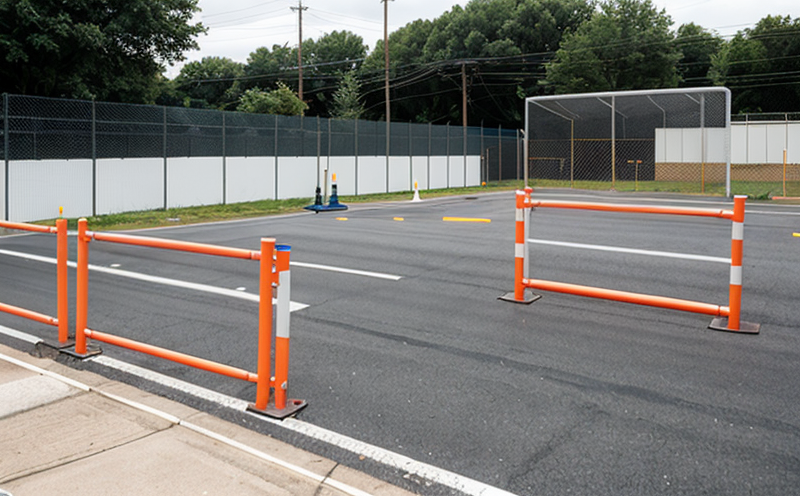Protective Shields & Barriers Testing
In the realm of occupational safety and protective equipment testing, protective shields and barriers are critical components designed to safeguard workers from hazards such as flying particles, radiation, and other potential threats. These shields play a pivotal role in enhancing workplace safety by creating a barrier between the worker and hazardous environments or activities.
The primary focus of this service is ensuring that these shields meet stringent safety standards and provide adequate protection against specified risks. Testing these shields involves rigorous evaluation using internationally recognized standards such as ISO 13688:2009, ASTM F752-14, and EN 374-1 to ensure they comply with the necessary performance criteria.
The testing process includes multiple stages aimed at assessing various aspects of a shield's design, material properties, and functionality. Material selection is crucial; it must resist deformation under stress without compromising on transparency or visibility for workers. The integrity test assesses how well the shield holds up against penetration by sharp objects, ensuring that it remains intact even in high-risk situations.
A second key aspect of testing involves evaluating the optical properties of these shields. This ensures they do not distort vision, which can be critical when performing tasks requiring precise hand-eye coordination or situational awareness. Additionally, tests are conducted to measure how well the shield deflects projectiles and other hazards, providing assurance that it offers robust protection.
Another important consideration is the durability of protective shields over time. Exposure to environmental factors like temperature extremes, humidity, and UV radiation can degrade materials used in their construction. Therefore, accelerated aging tests are often performed to simulate long-term use conditions and determine if a shield maintains its effectiveness throughout its lifecycle.
The robustness of the attachment mechanisms is also scrutinized during testing. Proper anchoring ensures that shields remain firmly in place despite impacts or vibrations, further enhancing safety. All these factors combined help guarantee that protective shields not only meet regulatory requirements but also provide effective protection for workers in potentially dangerous environments.
Scope and Methodology
The scope of our Protective Shields & Barriers Testing service encompasses a comprehensive assessment of the shield's performance across multiple dimensions. This includes evaluating the physical properties, optical characteristics, and durability of the material used for manufacturing. We employ state-of-the-art equipment calibrated according to international standards to ensure accurate results.
- Physical Properties: We examine the tensile strength, impact resistance, and flexibility of the shield materials.
- Optical Characteristics: Testing focuses on clarity, color fidelity, and glare reduction properties.
- Durability: Accelerated aging tests are conducted to assess long-term performance under various environmental conditions.
The methodology follows a structured approach starting with initial inspection of the product against specified criteria. Following this, detailed measurements and observations are made using specialized tools and techniques. Throughout each step, adherence to relevant standards like ISO 13688:2009 is strictly maintained to ensure consistency and reliability.
Once all tests have been completed successfully, a final report detailing findings and recommendations for improvement if necessary will be provided. This report serves as valuable documentation that can aid in decision-making processes related to purchasing or manufacturing decisions regarding protective shields.
Environmental and Sustainability Contributions
The importance of environmental responsibility extends beyond just compliance with regulations; it plays a crucial role in shaping sustainable practices within industries. By offering Protective Shields & Barriers Testing services, we contribute positively to this cause by promoting the use of eco-friendly materials and processes.
One significant contribution lies in reducing waste generation through proper material selection and efficient manufacturing methods. Using recycled or renewable resources not only conserves natural resources but also reduces landfill contributions significantly. Furthermore, optimizing production techniques helps minimize energy consumption during the manufacturing process.
Incorporating sustainable practices into testing protocols ensures that any new developments align with broader goals of environmental stewardship. For instance, choosing materials known for their high recyclability rates encourages circular economy principles while enhancing overall product sustainability.
The rigorous evaluation processes implemented ensure that only those products meeting stringent criteria are approved, thereby promoting quality and reliability in the market. This approach fosters trust among consumers who seek responsible business practices aligned with global initiatives aimed at preserving our planet for future generations.
Use Cases and Application Examples
| Application | Description |
|---|---|
| Mining Operations | Protective shields are used to shield miners from falling debris, dust particles, and other hazardous materials. |
| Hazardous Waste Handling | Safeguards workers dealing with toxic substances or infectious materials. |
| Blasting Activities | Keeps personnel safe from flying rocks and other projectiles generated during blasting operations. |
| Construction Sites | Shields construction workers against falling objects, sparks, and splinters of wood or metal. |
- Maintenance Workers: Shields protect maintenance personnel from exposure to hazardous chemicals while performing routine tasks.
- Manufacturing Plants: Ensures compliance with OSHA regulations regarding worker protection in high-risk areas within factories.
These examples illustrate the diverse applications of protective shields across various sectors. By providing tailored solutions based on specific industry needs, we ensure that each shield meets the unique challenges faced by professionals working in these environments.





